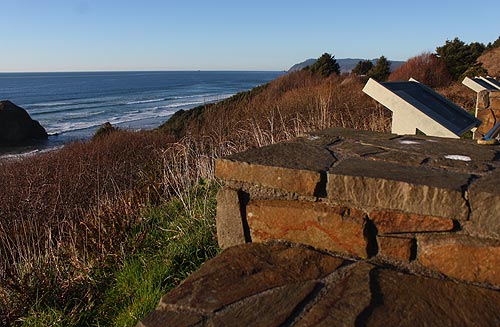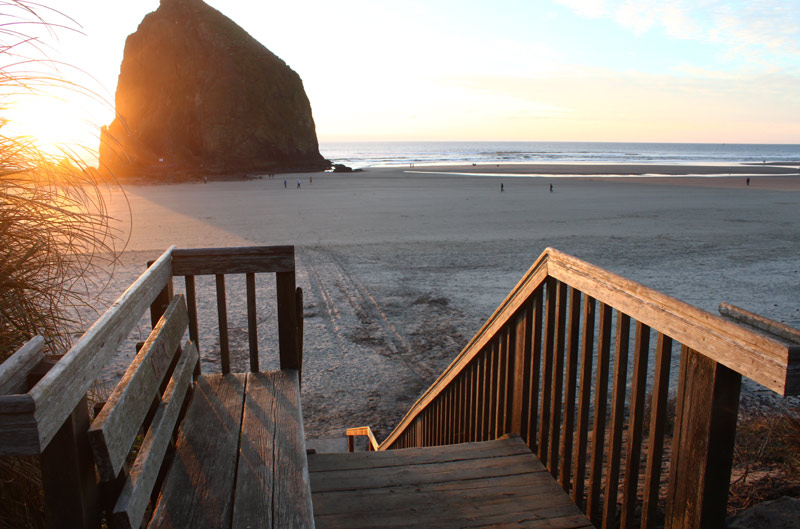Deeper Into Cannon Beach: History and Science Surprises of Oregon Coast Hotspot, Part I
Published 1/07/24 at 6:25 p.m.
By Oregon Coast Beach Connection staff

(Cannon Beach, Oregon) – Everyone knows Cannon Beach as a cajoling and charming little hamlet on the north Oregon coast that is one of the region's biggest attractions. Any time of year finds the place packed on most weekends and even weekdays, and it hosts one of the state's most photographed rocky features. Among coastal burghs, it's kind of a rock star (and yes that's meant as a pun as well).
Its natural pleasures are copious and well known, and even Cannon Beach's hotels, other lodgings and eateries are part of the draw. (Above: the myserious lighthouse offshore / Oregon Coast Beach Connection)
Includes exclusive listings; some specials in winter
In Cannon Beach:
Includes rentals not listed anywhere else
In Manzanita, Wheeler, Rockaway Beach:
Some specials for winter
In Pacific City, Oceanside:
Some specials for winter
In Lincoln City:
Some specials for winter
In Depoe Bay, Gleneden Beach:
Some specials for winter
In Newport:
Look for some specials
In Waldport
Some specials for winter
In Yachats, Florence
Some specials for winter
Southern Oregon Coast Hotels / Lodgings
Reedsport to Brookings, places to stay; winter deals
Yet there's more beneath the surface here – quite literally.
This is part one of a deeper dive into the Cannon Beach area, checking out the curiosities of science and history that shape what you do and see. Beneath Famed Oregon Coast Town: Surprising History and Science of Cannon Beach Part II
Silver Point Above and Below. One of the most famed of viewpoints on the Oregon coast lies immediately south of town, called Silver Point. It's one of the more photographed spots in the state as well, framing iconic Haystack Rock in a unique composition of trees and a different angle.

Yet few know you can wander beneath this turnout, but you have to walk a ways from the southernmost beach access. This is where some of the town's coolest treasures lie.

There's a trippy sea cave inside the mini-stack of dark rock, which is never actually accessible. However, if tides get low enough and sand levels rise just right, you can get near it – as Tiffany Boothe of Seaside Aquarium did here. She snagged the sweet money shot of wild tidepool action.

Geologically, this spot is a bit mind-blowing. Look at those huge grooves carved in the cliff face and you may think Ice Age movement. No, say local geologists. This area was once at the bottom of the sea, and those grooves come from currents ripping down it, like an underwater waterfall. See the full geologic story of Silver Point

Photo Jesse Jones / CoastWatch
Every once in awhile, sand levels get low enough in winter to show off the bedrock, which is itself some 18 million years old or so. This is what is actually beneath Cannon Beach the whole time you're walking on the sands. See ful story of Cannon Beach Bedrock / Oregon Coast Storms Reveal What's Beneath Cannon Beach at Silver Point
Haystack Rock's Fiery Origin Story. The massive, looming legend and icon of town actually has a bit of a scary tale behind it.

Some 14 million years ago or so, there was a massive hole in the Earth's crust in what is now Idaho, which in turn created lava flows so enormous they sizzled their way across 300 miles to the ocean and beyond, sometimes tens of feet high. The coastline was then several miles inland, but these lava flows were so powerful they plunged into sediment far offshore and then literally re-erupted at another location.
Called “invasives,” Haystack Rock was once part of a larger structure that came from this action. The rest of it eroded away, leaving the rock and its Needles.
A creepy factoid: that same hole in the crust is where Yellowstone National Park is now, and it will likely one day erupt again as a super volcano. Eerie Doomsday Connection Between Oregon Coast and Yellowstone
In case you didn't know: there are indeed three Haystack Rocks on Oregon's coast. The other biggie is in Pacific City and there's yet another in Bandon.

Tillamook Head by air
Lewis and Clark and Cannon Beach's First Review. It's fairly well known Clark and a few of the Corps of Discovery – including Sacegawea - journeyed from their ruddy temporary home of Fort Clatsop down to Ecola Creek in January of 1806, in search of blubber that local tribes were harvesting from a beached whale. There's a statue dedicated to this downtown at Whale Park.
What isn't so talked about is their leg cramp-inducing hike across Tillamook Head to its top, and what is now Bald Mountain. There was no trail then, and Clark had to pause for a moment to take in the scope of this march, feeling quite overwhelmed. But once he made it to the top, he was the first to document the soaring beauty of this spot that hikers for the last 100 years have relished so.
Clark raved about it, noting in those uniquely-stylized mispellings of the time that he could see the headland of Cape Disappointment (which the Corps named), and saying he "looked down with estonishment" at waves that crashed with ferocity. It was the Cannon Beach / Seaside area's first tourist review.
BONUS FACTOIDS: Just where did they film Goonies here in Cannon Beach? Filming The Goonies on N. Oregon Coast: at Astoria, Cannon Beach Yes, California backlots – and even a bit of Bodega Bay – were used in two-thirds of the movie. Yet The Goonies is regarded as an Oregon thing, a serious point of pride for residents.
Part two of this series looks into bunnies, puffins and some weird winter finds. Beneath Famed Oregon Coast Town: Surprising History and Science of Cannon Beach Part II
Hotels in Cannon Beach - Where to eat - Cannon Beach Maps and Virtual Tours
Cannon Beach Lodging
Nehalem Bay Lodgings
Manzanita Hotels, Lodging
Three Capes Lodging
Pacific City Hotels, Lodging
Lincoln City Lodging
Depoe Bay Lodging
Newport Lodging
Waldport Lodging
Yachats Lodging
Oregon Coast Vacation Rentals
Oregon Coast Lodging Specials
More About Oregon Coast hotels, lodging.....
More About Oregon Coast Restaurants, Dining.....
 Andre' GW Hagestedt is editor, owner and primary photographer / videographer of Oregon Coast Beach Connection, an online publication that sees over 1 million pageviews per month. He is also author of several books about the coast.
Andre' GW Hagestedt is editor, owner and primary photographer / videographer of Oregon Coast Beach Connection, an online publication that sees over 1 million pageviews per month. He is also author of several books about the coast.
LATEST Related Oregon Coast Articles
ODOT: Little Humbug Bridge On Route to N. Oregon Coast Soon Under Constructio...Near MP 8 on Hwy 26 to Seaside / Cannon Beach
When A Crusty Find Had Major Historical Implications for the N. Oregon Coast
Feb 2008 was a major discovery for Cannon Beach history
Coast Guard Calls Off Search Off Oregon Coast Near Cannon Beach - No Missing ...
Reports came late on Thursday of distress flares. Weather, Seaside, Arch Cape
Oregon's Tillamook Coast Offers Fascinating Ride Down State's History, Cool M...
450 Years of Black History in 45 Minutes in Nehalem, Feb 8; Movies in Tillamook. Manzanita events, Cannon Beach events, Tillamook events, Rockaway Beach events
Back to Oregon Coast
Contact Advertise on Oregon Coast Beach Connection
All Content, unless otherwise attributed, copyright Oregon Coast Beach Connection. Unauthorized use or publication is not permitted



















































